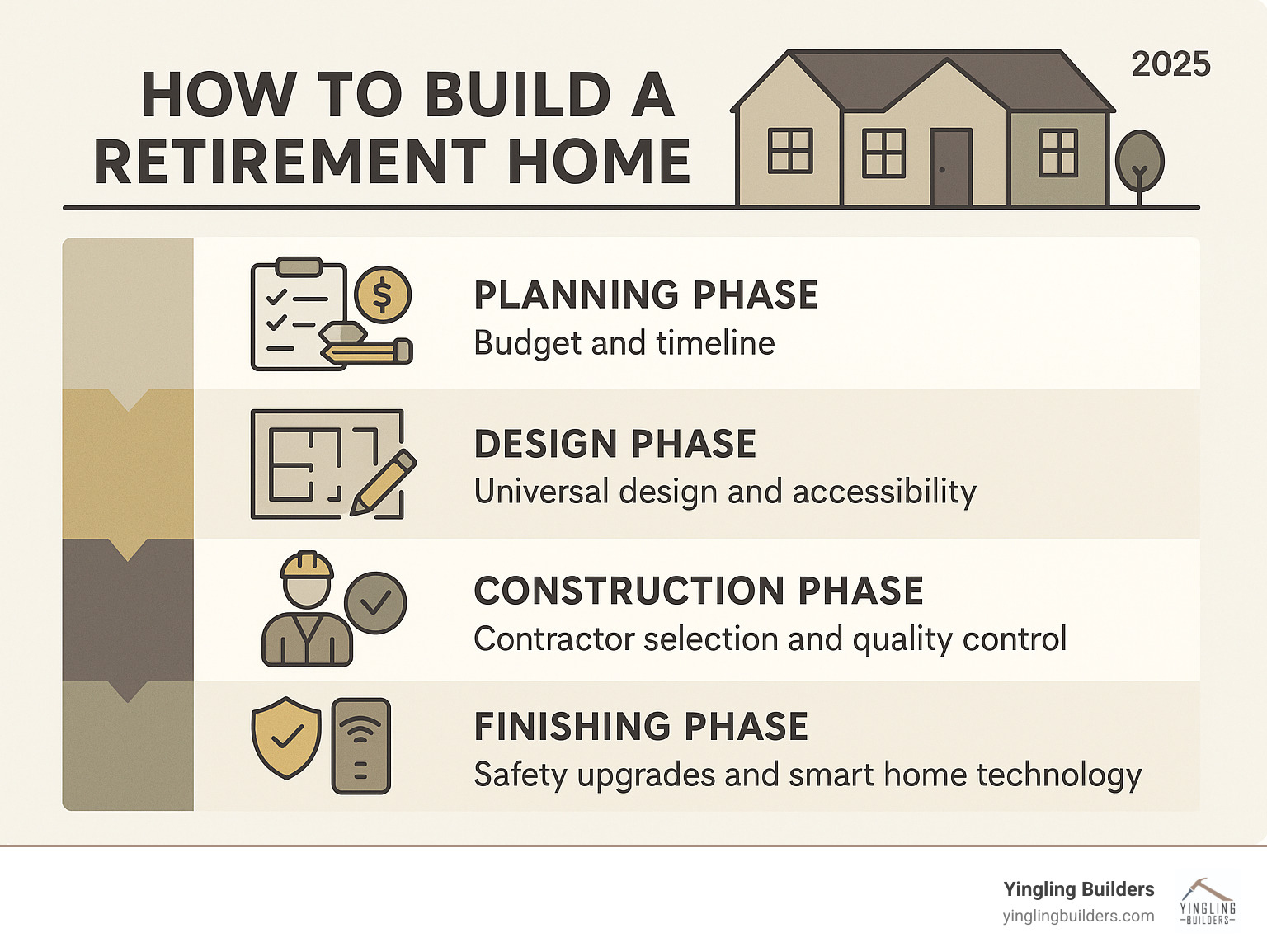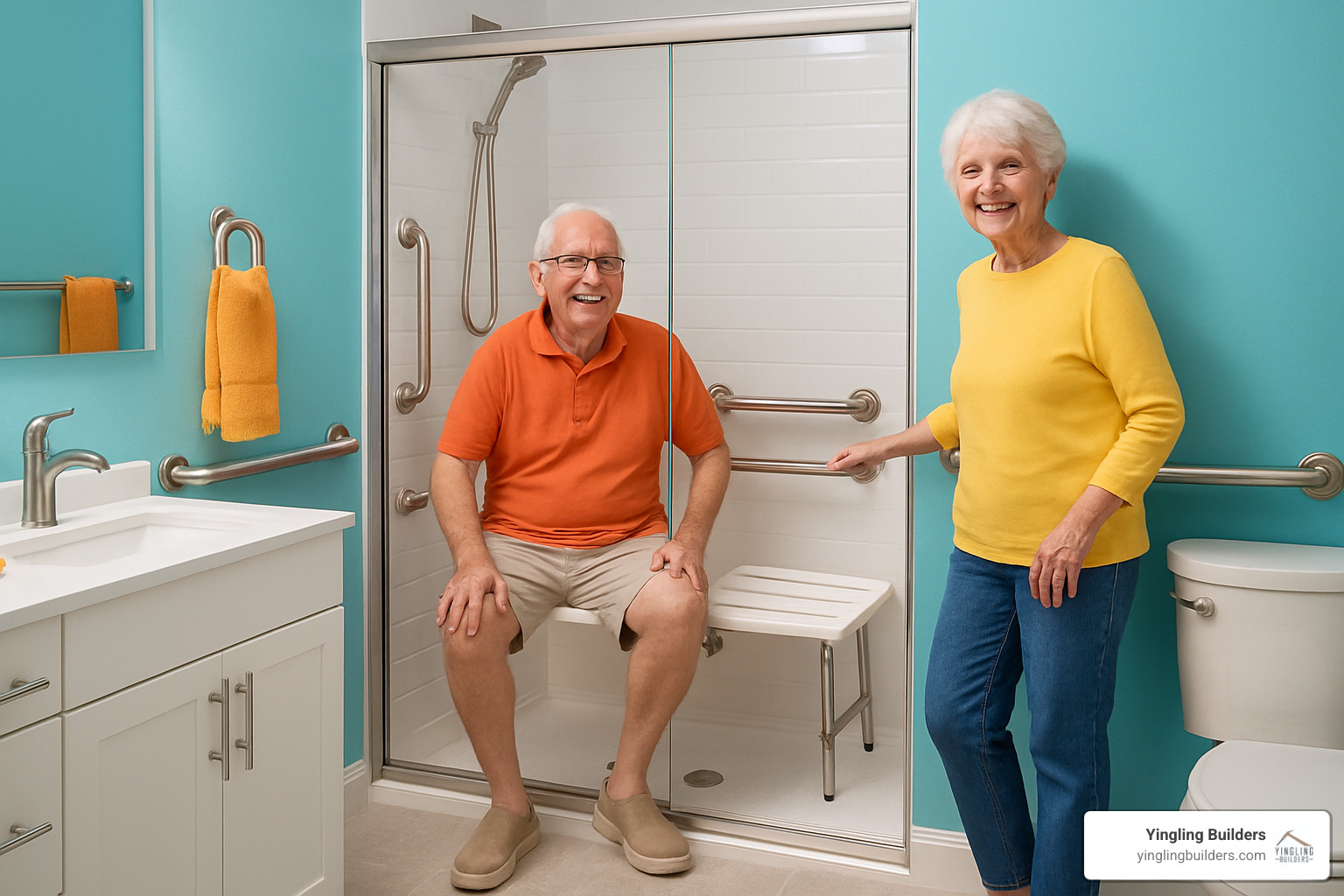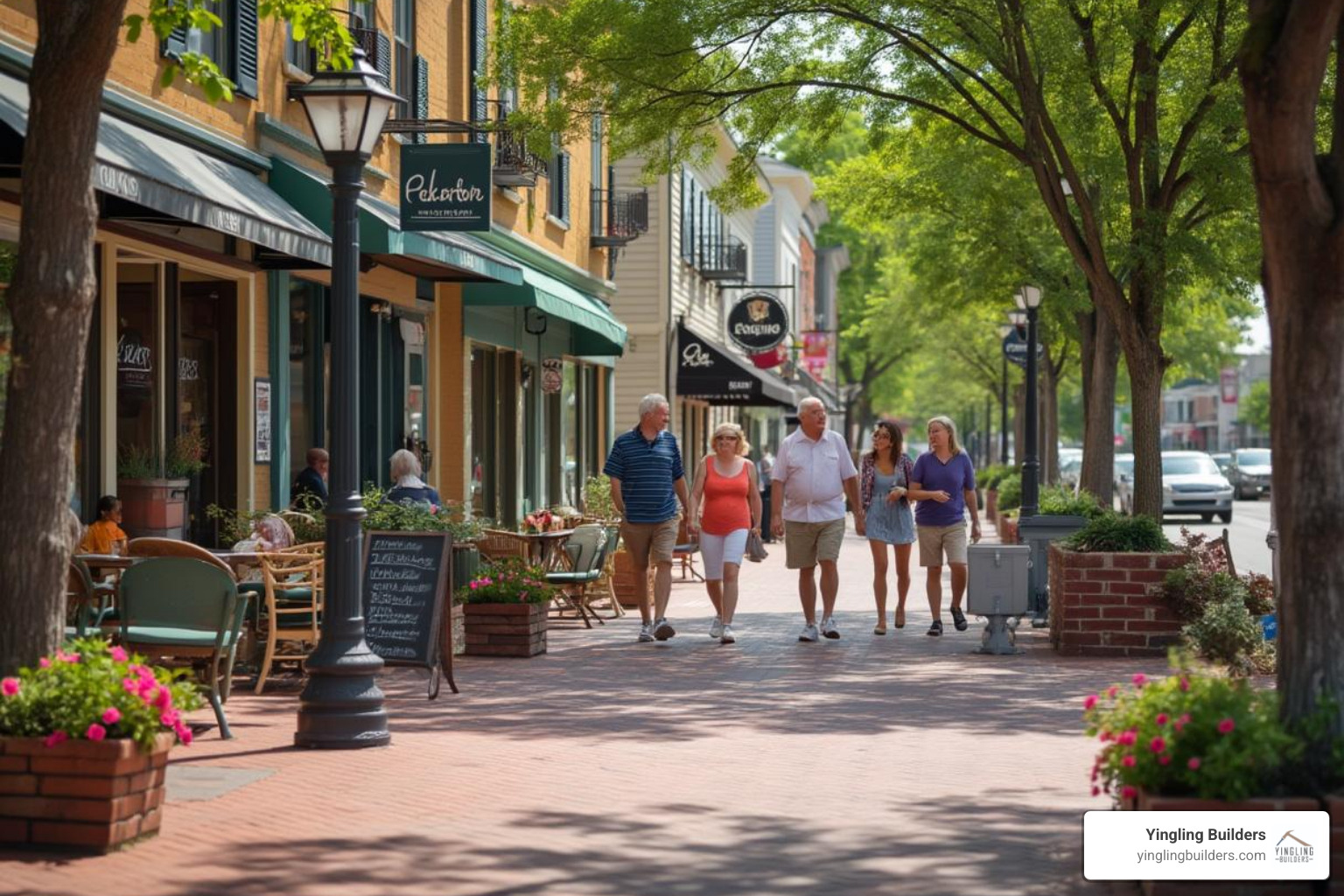Why Building a Retirement Home is Your Best Investment for the Future
When you build a retirement home, you’re making one of the most important decisions for your golden years. Here’s what the process involves:
Key Steps to Build a Retirement Home:
- Planning Phase: Define your vision, budget, and timeline
- Design Phase: Create accessible, age-friendly layouts with universal design
- Construction Phase: Work with qualified contractors and manage the build
- Finishing Phase: Add safety features, smart technology, and personal touches
Essential Features for Retirement Homes:
- Single-level living or main-floor master suite
- Wide doorways (36+ inches) and hallways
- Zero-step entries and barrier-free bathrooms
- Bright lighting and slip-resistant flooring
- Outdoor living spaces for entertaining
The numbers tell a compelling story. Over a fifth of the United States population will be 65 years or older by 2050, and nearly 80% of adults aged 50 or older prefer to stay in their home rather than move to assisted living. Building new allows you to integrate aging-in-place features from the start, avoiding costly renovations later.
Building a new home for retirement is a well-deserved and exciting endeavor as you move into your next chapter of life, but it requires careful planning to avoid common financial pitfalls that can drain your retirement savings.
The key is understanding that this isn’t just about downsizing – it’s about right-sizing for your lifestyle while preparing for future needs. Whether you’re looking at independent living, multi-generational options, or planning for potential care needs, custom construction gives you control over every detail.
I’m Seth Yingling, and with over 15 years of construction experience, I’ve helped countless families build a retirement home that perfectly fits their vision and budget. After building my own forever home with my wife Stephanie, I founded Yingling Builders in 2019 to help others create their ideal living spaces.

Define Your Retirement Living Vision
Before you break ground, you need to envision exactly how you want to spend your golden years. This isn’t just about choosing between a cozy cottage or a spacious ranch – it’s about understanding your lifestyle goals and planning for how your needs might evolve over time.
The retirement living landscape offers several distinct paths. Independent living focuses on maintaining your autonomy while enjoying amenities and community. Assisted living provides support services while preserving dignity and choice. Continuing care retirement communities offer a progression of care levels as needs change.
Most of our clients in West Central Illinois are drawn to the concept of “right-sizing” rather than simply downsizing. This means creating a home that perfectly fits your current lifestyle while anticipating future needs. Maybe you’re an empty nester who wants to trade maintenance headaches for more time with grandchildren.

We’ve found that successful retirement home projects start with honest conversations about future health considerations. While nobody wants to dwell on potential limitations, incorporating universal design elements from the beginning is far more cost-effective than retrofitting later.
More info about What to Consider Before Building Your Dream Home
Mapping Your Ideal Community
Location becomes even more critical when you’re building for retirement. Healthcare proximity should be a top priority – you’ll want quality medical facilities within reasonable driving distance. As we age, that 45-minute drive to the specialist becomes more challenging.
Walkability takes on new importance too. Can you safely walk to essential services like pharmacies, grocery stores, or community centers? These factors significantly impact your quality of life and independence as you age.
Family distance is another crucial factor. While you might crave the peace of rural acreage, consider how far you’ll be from children and grandchildren. Many of our clients find the sweet spot in smaller communities like Mt Sterling or Pittsfield, where they can enjoy small-town charm while staying within reasonable distance of family in larger cities.
Choosing the Right Home Type
The traditional single-family home remains the most popular choice for retirement, but it’s not your only option. We’ve helped clients explore various alternatives based on their specific needs and circumstances.
Accessory Dwelling Units (ADUs) offer an intriguing option for multi-generational living. You might build an ADU on your adult child’s property, maintaining independence while staying close to family.
55+ communities provide built-in social connections and shared amenities, but they’re not for everyone. Some clients love the activities and maintenance-free lifestyle, while others prefer the flexibility of unrestricted communities.
We’ve also seen growing interest in tiny homes and barndominiums for retirement. These options can dramatically reduce living expenses, but they require careful consideration of space limitations and resale value.
Forecasting Space & Layout Needs
Right-sizing your retirement home requires honest assessment of your current and future needs. Start with room count – do you really need four bedrooms, or would three bedrooms with a dedicated office or craft room serve you better?
Storage needs often surprise retirees. While you might be downsizing possessions, you’ll likely want space for seasonal items, hobby supplies, and keepsakes. We recommend planning for more storage than you think you need.
Hobby zones are becoming increasingly important in retirement home design. Whether it’s a woodworking shop, craft room, or reading nook, having dedicated space for your passions improves your quality of life.
Guest suites deserve special consideration. Will you have frequent visitors? A well-designed guest suite with its own bathroom provides flexibility for changing circumstances.
The Blueprint: How to Build a Retirement Home Step-by-Step
Building a retirement home involves more complexity than typical home construction because you’re planning for decades of use and changing needs. The process requires careful coordination between multiple professionals and thorough attention to accessibility features.
Our custom planning process begins with understanding your complete vision – not just how you want to live today, but how your needs might evolve over the next 20-30 years. This long-term perspective influences every decision from lot selection to fixture placement.
The permit process for retirement homes can involve additional considerations, especially if you’re incorporating accessibility features. We handle all permit applications and ensure compliance with local building codes and ADA requirements where applicable.
Timeline management becomes crucial when building for retirement. Many clients are working with specific move-out dates from their current homes or coordinating with retirement timing. We develop realistic schedules that account for weather delays and inspection requirements.
| Build Type | Timeline | Cost Control | Stress Level | Customization |
|---|---|---|---|---|
| DIY Build | 12-24 months | High risk | Very high | Complete |
| Turnkey Build | 6-12 months | Predictable | Low | Moderate |
| Hybrid Build | 8-16 months | Moderate | Moderate | High |
More info about Custom Home Steps
Pre-Construction Checklist to Build a Retirement Home
Site analysis takes on added importance when building for retirement. We evaluate not just the building envelope, but also factors like drainage, sun exposure, and accessibility from the street.
Zoning research is crucial, especially if you’re considering future modifications like adding an ADU or converting space for care services. Some municipalities have restrictions that could limit your options later.
Soil tests help prevent costly surprises during construction. Poor soil conditions can significantly impact foundation costs and timeline. We always recommend comprehensive soil analysis before finalizing lot purchases.
Bid comparisons require careful attention to specifications, especially for accessibility features. A lower bid might exclude important elements like grab bar backing or proper lighting placement.
Contingency funds are essential for retirement home builds. We recommend setting aside 15-20% of your construction budget for unexpected issues or upgrades.
Construction & Finishing Touches to Build a Retirement Home
Foundation work for retirement homes often includes additional considerations like basement accessibility and proper drainage for mobility equipment. We pay special attention to creating level transitions and proper waterproofing.
Framing stage is when we install backing for future grab bars, even if you don’t need them immediately. This invisible preparation saves thousands of dollars in renovation costs later. We also ensure proper spacing for wheelchair accessibility.
The energy-efficient shell becomes even more important for retirement homes because you’ll likely be spending more time at home and want to minimize utility costs on a fixed income. We focus on high-performance windows, superior insulation, and right-sized HVAC systems.
Punch lists for retirement homes include specific safety and accessibility checks that go beyond standard construction requirements. We verify that all transitions are smooth, lighting is adequate, and safety features are properly installed.
The handover process includes detailed documentation of all accessibility features, warranty information, and maintenance schedules. We want you to feel completely confident in your new home’s operation and care requirements.
Smart Design for Aging in Place
Universal design principles form the foundation of every retirement home we build. These features benefit everyone, not just those with mobility challenges, and they’re much more cost-effective to install during construction than to retrofit later.
Zero-step entries eliminate the most common barrier to aging in place. We design attractive, accessible entrances that don’t look institutional. This might involve creative grading, decorative ramps, or raised patios that provide level access while maintaining curb appeal.
Wide doorways and hallways accommodate not just wheelchairs and walkers, but also make everyday living more comfortable. Moving furniture, carrying laundry, or simply navigating with packages becomes easier with generous passage widths.
Lighting design takes on critical importance as we age. We install multiple light sources in each room, minimize shadows, and ensure adequate illumination for tasks like reading and cooking. LED fixtures provide energy efficiency and long life.
Slip-resistant flooring prevents falls, the leading cause of injury among seniors. We select materials that provide traction without being difficult to clean. Smooth transitions between different flooring materials eliminate trip hazards.
Grab-bar backing throughout bathrooms provides future flexibility. Even if you don’t install grab bars immediately, having proper backing in place means you can add them easily when needed.
Smart-home technology improves safety and convenience. Voice-controlled lighting, thermostats, and security systems reduce the need for physical manipulation of switches. Emergency alert systems provide peace of mind.

Scientific research on aging in place
Universal Design Must-Haves
Single-level living eliminates the most significant barrier to aging in place. While two-story homes can work with proper planning, having all essential living spaces on one level provides the greatest long-term flexibility.
The 5-foot turning radius standard ensures wheelchair accessibility throughout your home. This affects hallway widths, bathroom layouts, and kitchen design. While you might not need wheelchair access today, planning for it ensures your home remains functional regardless of future mobility changes.
Lever handles on doors and faucets are easier to operate than knobs, especially for those with arthritis or limited hand strength. This simple upgrade costs little during construction but provides significant long-term benefits.
Tech & Sustainability Upgrades
Voice controls for lighting, temperature, and security systems reduce the need for physical switches and complex controls. These systems continue improving and becoming more affordable.
Fall sensors and emergency alert systems provide safety monitoring without being intrusive. Modern systems can differentiate between normal activities and potential emergencies.
Solar installations make particular sense for retirement homes because you’ll likely be home during peak sun hours and benefit from reduced utility costs on a fixed income. Combined with energy-efficient design, solar can dramatically reduce ongoing housing expenses.
High-R insulation and energy-efficient windows provide consistent comfort while minimizing heating and cooling costs. This is especially important in Illinois where weather extremes can create significant utility expenses.
Creating Community Spaces
Outdoor kitchens extend your entertaining space and provide pleasant areas for meal preparation and dining. These spaces are particularly valuable for retirees who enjoy hosting family gatherings.
Hobby workshops give you dedicated space for woodworking, crafts, or other interests. Proper ventilation, storage, and accessibility make these spaces functional for years to come.
Shared gardens provide opportunities for physical activity, social interaction, and connection with nature. Even small garden areas can provide significant benefits for mental and physical health.
Social hubs like covered porches, fire pit areas, or game rooms create natural gathering spaces for family and friends. These areas become increasingly important as social circles naturally contract with age.
Financing, Budgeting & Legalities
Financial planning for retirement home construction requires careful consideration of both upfront costs and long-term expenses. The goal is creating a home that improves your retirement lifestyle without straining your finances.
Land costs vary significantly across West Central Illinois. Rural acreage near smaller communities like Perry or Camden typically costs less than lots in established neighborhoods closer to larger cities like Jacksonville or Quincy.
Construction loans for retirement homes often involve different considerations than traditional mortgages. Lenders may evaluate retirement income differently, and you might need larger down payments. We work with several local lenders who understand retirement construction financing.
The decision between down payment financing and paying cash involves multiple factors. While paying cash eliminates mortgage payments, it also ties up liquid assets that might be needed for other expenses.
Closing costs for new construction typically run around 10% of the total project cost. This includes various fees, inspections, and final loan processing. We help clients budget for these expenses to avoid surprises.
Various grants and incentives might be available for energy-efficient construction or accessibility features. These programs change frequently, but we stay informed about current opportunities.
More info about Budgeting for a Custom Build
Scientific research on senior housing costs
Avoiding Common Financial Pitfalls
Overestimating your current home’s sale price is one of the most common mistakes we see. It’s easy to get caught up in peak market valuations, but you need realistic expectations for timing your sale and funding your new construction.
Liquidity traps occur when retirees invest too much cash in their new home, leaving insufficient funds for other needs. Home equity, while valuable, isn’t easily accessible for emergencies. Maintaining adequate liquid savings is crucial for financial security.
Rising taxes can significantly impact retirement budgets. New construction often results in higher property tax assessments, and some areas have additional taxes for new development.
Funding Options & Incentives
Home Equity Lines of Credit (HELOCs) on your current home can provide construction funding while preserving other assets. This strategy works well if you plan to sell your current home after completing your retirement home.
Reverse mortgages might be appropriate for some retirees, though they require careful consideration of terms and long-term implications. These products have evolved significantly and might provide viable funding.
State grants for energy efficiency, accessibility modifications, or rural development might be available. Illinois offers various programs that change periodically.
Energy rebates from utility companies can offset the cost of high-efficiency equipment and systems. These rebates often require specific equipment specifications and professional installation.
Regulatory Checkpoints
ADA standards apply to certain aspects of residential construction, especially if you’re planning for potential care services or rental income. Understanding these requirements early prevents costly modifications later.
State senior-care regulations become relevant if you’re considering any type of care services. These regulations affect everything from building design to operational requirements.
HOA rules in planned communities might restrict certain modifications or use types. Understanding these restrictions is crucial for long-term planning.
Location, Amenities & Market Appeal
Choosing the right location for your retirement home involves balancing personal preferences with practical considerations. The perfect location provides access to healthcare, recreation, and social opportunities while offering the lifestyle you desire.
Healthcare networks become increasingly important as we age. Research the quality and availability of medical services in your chosen area. In West Central Illinois, larger communities like Jacksonville and Quincy offer more comprehensive medical services, while smaller towns provide closer-knit healthcare relationships.
Transit options affect your long-term independence. Even if you’re comfortable driving now, consider what transportation alternatives exist for the future. Some communities offer senior transportation services.
Recreation opportunities contribute significantly to retirement satisfaction. Whether you enjoy golf, fishing, hiking, or cultural activities, having access to your preferred pastimes improves your quality of life.
Cultural venues and social opportunities prevent isolation and maintain mental stimulation. Libraries, community centers, theaters, and educational institutions provide ongoing engagement opportunities.
Safety considerations include both crime rates and emergency services. Research local crime statistics and emergency response times. Rural areas might offer peaceful living but longer emergency response times.

More info about Custom Home Design
Amenities Today That Add Value Tomorrow
Clubhouse facilities in planned communities provide social gathering spaces and organized activities. These venues often host everything from fitness classes to social events, creating natural opportunities for community engagement.
Swimming pools offer low-impact exercise opportunities that become increasingly valuable with age. Whether it’s a community pool or your own, aquatic exercise provides excellent fitness benefits with minimal joint stress.
Walking trails and parks encourage daily physical activity in safe, pleasant environments. Well-maintained trails with appropriate lighting and seating areas support active lifestyles regardless of fitness level.
Maker spaces and workshops provide opportunities for creative pursuits and skill development. These shared facilities might include woodworking shops, craft rooms, or technology centers.
Pet parks and pet-friendly amenities recognize the important role pets play in retirement happiness. Many retirees find that pets provide companionship, encourage activity, and improve overall well-being.
Standing Out in a Competitive Market
Distinctive architecture helps your retirement home stand out while reflecting your personal style. This doesn’t mean expensive or elaborate design, but rather thoughtful details that create visual interest and curb appeal.
Memory-friendly wayfinding becomes important if you’re building in a community setting or planning for potential cognitive changes. Clear sight lines, consistent design elements, and intuitive layouts support navigation.
Green certifications and sustainable features appeal to environmentally conscious buyers and provide ongoing cost savings. Energy-efficient systems, sustainable materials, and water conservation features demonstrate forward-thinking design.
Frequently Asked Questions about Building a Retirement Home
How long does it take to build a retirement home?
Building a retirement home typically takes 6-12 months from groundbreaking to move-in, though the complete process including planning and permitting can extend to 12-18 months. The timeline depends on several factors including the complexity of your design, accessibility features, weather conditions, and permit processing times.
Custom retirement homes often take longer than standard construction because of the additional planning required for universal design features. However, this extra time investment pays dividends in creating a home that truly meets your long-term needs.
We recommend starting the planning process 12-18 months before you want to move in. This allows adequate time for design development, permit approval, and construction without rushing decisions.
What size home is best for aging in place?
The best size for a retirement home depends on your specific needs and lifestyle, but most successful aging-in-place homes fall between 1,200 and 2,000 square feet. This size range provides adequate space for comfortable living while remaining manageable for maintenance and cleaning.
Single-level homes work best for aging in place, eliminating stairs and providing easier navigation. If you prefer a two-story design, ensure all essential living functions are available on the main floor.
The key is right-sizing rather than simply downsizing. Focus on creating functional spaces that support your lifestyle and hobbies while eliminating unnecessary square footage.
Is building in a 55+ community better than on private land?
Both options have advantages depending on your priorities and lifestyle preferences. 55+ communities offer built-in social opportunities, shared amenities, and often include maintenance services that reduce your responsibilities.
Private land offers more flexibility in design, use, and modifications. You can have pets without restrictions, host multi-generational gatherings, and modify your property as needs change. Rural or suburban private lots often provide more space, privacy, and connection with nature.
Consider your personality, social needs, and long-term plans when making this decision. If you thrive on social interaction and prefer maintenance-free living, a 55+ community might be ideal. If you value privacy and flexibility, private land might better suit your needs.
Conclusion
Building your perfect retirement home is about more than creating a beautiful space – it’s about investing in your future comfort, safety, and happiness. When you build a retirement home with thoughtful planning and expert guidance, you’re creating a foundation for decades of enjoyable living.
The key to success lies in balancing your current desires with future needs, incorporating universal design principles that support aging in place, and working with experienced professionals who understand the unique requirements of retirement home construction.
At Yingling Builders, we’ve helped countless families across West Central Illinois create their ideal retirement homes. From our locations in communities like Mt Sterling, Jacksonville, and Quincy to smaller towns like Perry and Camden, we understand the unique character and needs of our region.
Our approach combines the quality and customization of Wausau Homes with our local expertise and commitment to stress-free construction. We handle every detail from initial planning through final walkthrough, ensuring your retirement home building experience is as smooth and enjoyable as possible.
Your retirement home should be a source of joy and peace of mind, not stress and worry. With proper planning, thoughtful design, and experienced construction management, you can create a home that improves every aspect of your retirement lifestyle.
Ready to start planning your perfect retirement home? We’re here to help you steer every step of the process, from initial vision to final details. Your dream retirement home is closer than you think.

0 Comments